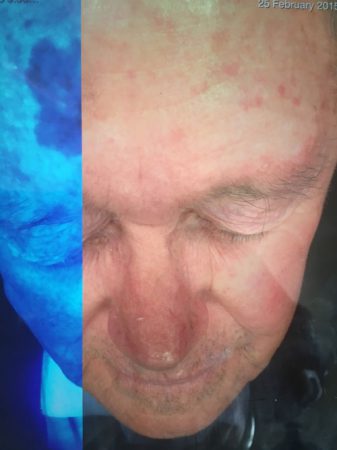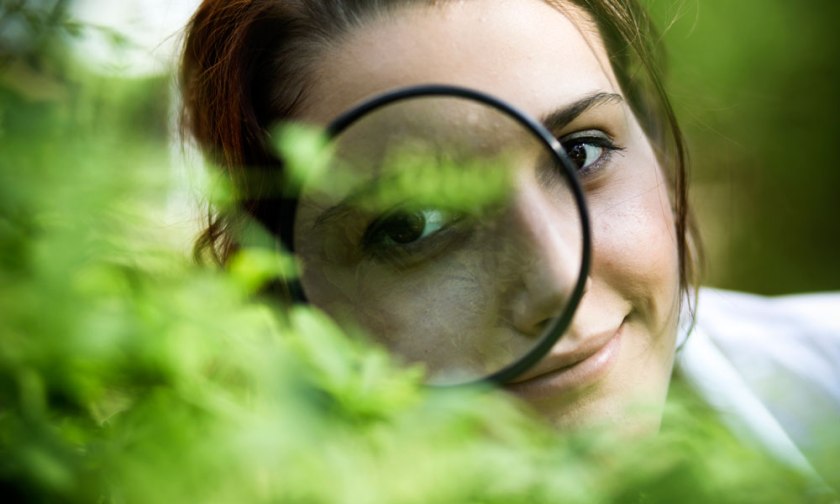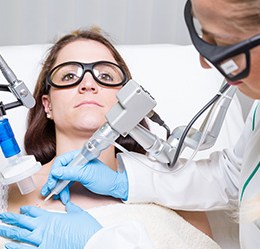Treating lumps, bumps, spots and rashes, red and brown (and other hues of the rainbow) patches on the surface of the skin is the lifeblood of our industry.
Yet addressing what lurks beneath is ultimately the most significant concern, to prevent further surface issues from erupting. And diagnosing problems at the source can be life-changing, literally.
Sounds overly dramatic? No. Skin concerns on an aesthetic level can actually be harbingers of potential doom – thus can save a person from life-threatening consequences.
Take this example from Margaret Walsh, owner of Face and Body salon in Auckland, New Zealand, and director/distributor of Observ skin analysis technology in Australasia.

“This gentleman (pictured above) walked into my salon complaining of a very dry, itchy forehead with obvious pigment showing, as can be seen in the daylight mode visual of Observ on the right,” Margaret says.
“He said he had had IPL treatment elsewhere three weeks prior to remove the `brown pigmentation’.
“I ghosted over the black light UV mode visual to unearth this melanoma! I immediately emailed the visual to my referring dermatologist and discussed it on the phone with him.
“The client was operated on at 7am next day.”
Skin analysis technology is also changing the landscape of skin treatment protocols across the board.
“I invested in the observ device two years ago after seeing it in its early stages of development,” says Robyn McAlpine, owner of Laser Effect in Perth.
“I could see that this device was going to be and asset to mine and many skin-focused businesses.
“Having the observ not only allows us to make an accurate diagnosis but it also allows our clients to see what we see, so they become more engaged in the skin revision process. It gives us such a great foundation to base our treatment program on because there’s no guess work, only evidence.
“We haven’t seen any active skin cancers presenting but with this technology we are able to see a lot of the early signs of sun damage.
“This allows us to put a treatment plan in place to work on creating the best skin possible and reducing the need for more drastic interventions required for skin issues at an advanced stage.
“Seeing skin change in front of your eyes is extremely powerful. Not only does it instill confidence, knowing we are starting off on the right foot, having such clear and focused images means there’s no secrets and nowhere to hide.
“From a therapist standpoint, it keeps us accountable to ensure we are actively working towards results!”
Before treating skin conditions such as pigmentation, skin analysis technology also helps to guide the therapist as to what kind of treatments are suitable for a client – and what are contra-indicated.
Using the wrong type of device, depending on the nature of a client’s, say, pigmentation, can be at best useless, at worst have catastrophic results that worsen their condition or even injure them.
Laser and IPL are the most commonly used devices for treating dark spots and patches and thorough training is required before operating any of these devices, but also an understanding of the nature of the condition you’re treating.
It is strongly recommended that clients sign a consent form stating they have had skin cancer checks within the previous six to 12 months as, if a discolouration is “suspicious”, the light- based treatments can accelerate malignancy.
Also, conduct a consultation to get their medical history and any factors that may contraindicate them for suitability. The number and frequency of treatments with either technology depends on the power of the device and the extent of the client’s condition.
Laser tends to be a more aggressive treatment than IPL but in both cases, clients must be warned to strictly observe sun protection after treatments.
Even an hour’s over-exposure to UV rays can take their skin back to ground zero, or even make it worse than it was before.
Lasers treat pigmentation by delivering an intense beam of light that specifically targets melanin, the pigment molecule that is responsible for pigmentation disorders.
This light is then absorbed and converted into heat, which either disperses the group of melanin cells or destroys the skin cells carrying the pigment molecule.
For pigmentation, the most widely used laser is the Q-switch Nd:Yag laser. Other effective lasers include CO2, erbium:yag, ruby, thullium, and alexandrite.
IPLs release short pulses of filtered light that is readily absorbed by the high concentration of melanin found within freckles, sun spots or age spots.
The rapid absorption of light energy heats the melanin and causes the destruction of the melanin-rich cells.
However, large, dark, mottled or raised pigmentation cannot be treated and may need to be checked by a dermatologist or other experienced medical professional.
Large, dark moles should not be treated, nor should lesions covering a large part of the body. The pigmented marks that respond the best are superficial lesions such as those caused by sun damage (sun spots) and freckles.
After both laser and IPL treatments, pigmented lesions will darken and may appear more obvious before they fade and “flake” away.
These devices come with a list of possible side effects. So we stress again that your level of expertise and training should dictate the types of devices best suited to your business. It is also absolutely essential that during treatments protective eye wear is worn by both operator and client.
If you buy a machine from a company that doesn’t offer prudent advice (or buy one second hand or online) and start operating it without a thorough understanding of its capabilities – or yours – there is a considerable risk of making a client’s condition worse. Much worse, injuring them. Not to mention the ramifications for your business.
There is a possibility that the skin undergoing treatment becomes darker (or even lighter) than the surrounding skin, or it could burn, blister and then scar.




